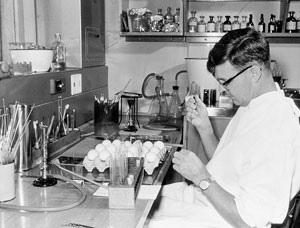Frank Fenner was one of Australia’s greatest scientists, internationally recognised for his research into viral diseases and for his achievements in the eradication of smallpox and the control of Australia’s rabbit plague.

In 1967, he left bench for books to become the first Director of the JCSMR. His most notable publications were The biology of animal viruses (New York: Academic Press, 1968) and Medical virology (New York: Academic Press, 1974). His experience with pox viruses led to an invitation to join an international scientific project to eliminate smallpox and, in 1977, to his appointment as Chairman of the Global Commission for Certification of Smallpox Eradication. He later nominated 8 May 1980, when he announced the eradication to the World Health Assembly, as the proudest day of his life.
Frank Fenner died on 22 November 2010 after being admitted to hospital with septicaemia. He is survived by his daughter Marilyn.
- Peter McCullagh




